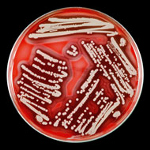You are here:
Staphylococci

Characteristics
Staphylococci are gram-positive, immobile, coccoid bacteria which belong to the family of Staphylococcaceae. They grow under aerobic conditions, but also in an oxygen-reduced atmosphere and occur naturally in humans and animals as colonizers of skin and mucosa (mainly of the nasopharynx). However, Staphylococci are also the cause of many infectious diseases in humans and animals. Often they cause purulent infections of the skin and soft tissues like boils and wound infections. Furthermore, serious systemic infections can develop into pneumonia, endocarditis or sepsis. In animals, they also cause mastitis, and thus can affect milk production, especially in dairy cows.
A particular challenge is the occurrence of multi-resistant strains, including methicillin-resistant Staphylococcus aureus (MRSA)  (284.6 KB), as infections with these strains are difficult to treat due to their resistance to multiple classes of antimicrobials. Certain types of MRSA, the so-called livestock-associated MRSA, occur in different farm animals (especially in pigs and poultry) as well as in the food production chain.
(284.6 KB), as infections with these strains are difficult to treat due to their resistance to multiple classes of antimicrobials. Certain types of MRSA, the so-called livestock-associated MRSA, occur in different farm animals (especially in pigs and poultry) as well as in the food production chain.
In addition, toxin-producing Staphylococci can induce food-borne intoxications (i.e. food poisoning) in humans.
Food intoxication via staphylococcal enterotoxins
The importance of coagulase positive staphylococci, mainly Staphylococcus aureus, in terms of food hygiene is their ability to produce staphylococcal enterotoxins (SEs) and staphylococcal enterotoxin-like (SE-like) proteins. Ingestion of even small quantities (micrograms) of SEs with contaminated food can result in severe emetic activity (nausea, vomiting, etc.) that can last for several days. SEs can also function as superantigens (SAgs) that directly activate certain T-cells and ultimately lead to a misregulation of the immune system. At present, more than 20 different types of SEs and SE-like SAgs have been described, although the stimulation of emetic activity by SE-like SAgs is, however, not yet proven. The highest significance as a cause of food intoxication is attributed to the five classical toxin types referred to as SEA - SEE, but other types such as SEG, SEH, and SEI have also been described in association with foodborne illnesses. Nevertheless, their relevance is difficult to assess due to a lack of standardized detection procedures. Furthermore, there is currently too little known regarding coagulase negative staphylococci as causative agents of intoxication.
Staphylococcal enterotoxins are among the leading causes of foodborne illness outbreaks worldwide. Primary risks originate from manually prepared, protein-rich meals, e.g. carved joints, delicatessen salads, desserts, home-made ice-cream, pasta and food made with raw milk. A prerequisite for any foodborne intoxication caused by staphylococci is sufficient multiplication of bacteria in food and consequent production of enterotoxins - most often resulting from inadequate cooling of prepared food. The enterotoxins themselves are resistant to extreme conditions like high heat, low pH and proteolytic enzymes, and thus are able to withstand inactivation during gastric transit or the heating of food. The time span from ingestion of enterotoxins in food to the onset of first symptoms is generally short - from a few minutes up to seven hours.
